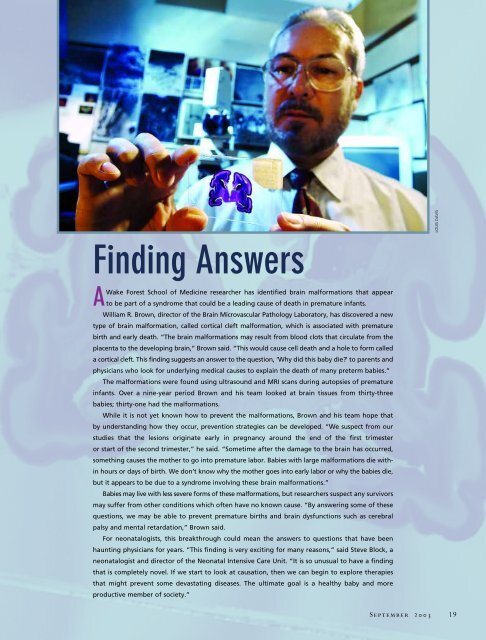Tamara Jones and her two sons, both of whom were born prematurely.“I’m just very grateful. Dr. Meis is not only a very gooddoctor, he’s a very nice person.”Tamara Jonesof 17P beginning at sixteen to twentyweeks of pregnancy and stopping at thirtysixweeks.The other one-third weregiven a placebo.The results startled even the mostsanguine among the research group. Inthe placebo group, 54.9 percent of thewomen gave birth before thirty-sevenweeks, compared with 36.3 percent ofthose who got hormone shots—a riskreduction of 34 percent.The resultswere even more pronounced for severelypremature births occurring before thirtytwoweeks: 19.6 percent in the placebogroup, and 11.4 percent in the hormonegroup, for a risk reduction factor of 42percent. So conclusive were the outcomesthat the study was stopped early becauseit was thought that to continue administeringa placebo to high-risk womenwould be unethical. Meis presented thefindings at a meeting of the Society forMaternal-Fetal Medicine in San Francisco,and the study was published in June in thecountry’s top medical research periodical,the New England Journal of Medicine.Tamara Jones of Walkertown, NorthCarolina, was a participant in the study.In 1997, she gave birth twelve weeksprematurely to a three-pound, one-ounceboy who miraculously escaped permanentbrain damage despite bleeding on theright side of his brain.The child requiredthree blood transfusions and a hugelyexpensive sixty-one-day hospital stay,most of that in intensive care. In late2000, she became pregnant again, and sheconsulted a specialist, who told her aboutMeis and the study. She enrolled, and inAugust 2001 her second son was born.He also was premature, but by only fourweeks, and he weighed a relatively robustsix pounds, ten ounces and was in goodhealth. “I can’t be sure, but I think I wasgiven the real thing and not the placebo,”said Jones, thirty-three. “There weretimes when I thought I might have contractions,but they didn’t happen. I’mjust very grateful. Dr. Meis is not only avery good doctor, he’s a very nice person.”That seems to be the consensus opinionof his patients and colleagues. Quiet andlow-key, with soft eyes and a warm smilethat inspire confidence and trust, he isknown as a humble and self-effacingresearcher, quick to deflect credit awayfrom himself and toward others. “It isreally gratifying to have this success forthe network,” he says of the study. He isadmired as a caring clinician who devotesas much time and attention as requiredto each patient he sees at <strong>Wake</strong> <strong>Forest</strong>University Baptist Medical Center andpublic health clinics in Yadkin and Daviecounties. He keeps in touch with manymothers he brought through difficultpregnancies as their children grow up.And he is hailed as a fellow of wit, asexemplified by the sign on his office doorproclaiming his ardent belief in “lost causes”ranging from Macintosh computers andthe doctor-patient relationship to worldpeace and environmental protection. Butbeneath his humility and his understatedhumor is an intensity and seriousness ofpurpose that fuel his other interests aswell—vintage racecar driving, winemaking,biking, and world travel with culturalexchange groups. One of his two sons—Winston-Salem attorney Douglas J. Meis(JD ’90)—is his racing companion.At sixty-eight, Meis has no intentionof retiring to his hobbies anytime soon.“They threw a retirement party for mesix years ago but I won’t go away,” hequips. Indeed he won’t: he and theMFMU are planning a follow-up studyin which women will be given omega-3fatty acids in combination with 17P.Fatty-acid deficiencies have been linkedto premature birth, and they hope to findout whether providing them can producean even stronger benefit than 17P alone,especially for women with multiple fetuses.“As remarkable and gratifying as thestudy has been, this treatment is not asolution to preterm birth,” he says. “Butit is a start.”18 <strong>Wake</strong> <strong>Forest</strong> <strong>Magazine</strong>
LOUIS DAVISFinding Answers<strong>Wake</strong> <strong>Forest</strong> School of Medicine researcher has identified brain malformations that appearA to be part of a syndrome that could be a leading cause of death in premature infants.William R. Brown, director of the Brain Microvascular Pathology Laboratory, has discovered a newtype of brain malformation, called cortical cleft malformation, which is associated with prematurebirth and early death. “The brain malformations may result from blood clots that circulate from theplacenta to the developing brain,” Brown said. “This would cause cell death and a hole to form calleda cortical cleft. This finding suggests an answer to the question, ‘Why did this baby die?’ to parents andphysicians who look for underlying medical causes to explain the death of many preterm babies.”The malformations were found using ultrasound and MRI scans during autopsies of prematureinfants. Over a nine-year period Brown and his team looked at brain tissues from thirty-threebabies; thirty-one had the malformations.While it is not yet known how to prevent the malformations, Brown and his team hope thatby understanding how they occur, prevention strategies can be developed. “We suspect from ourstudies that the lesions originate early in pregnancy around the end of the first trimesteror start of the second trimester,” he said. “Sometime after the damage to the brain has occurred,something causes the mother to go into premature labor. Babies with large malformations die withinhours or days of birth. We don’t know why the mother goes into early labor or why the babies die,but it appears to be due to a syndrome involving these brain malformations.”Babies may live with less severe forms of these malformations, but researchers suspect any survivorsmay suffer from other conditions which often have no known cause. “By answering some of thesequestions, we may be able to prevent premature births and brain dysfunctions such as cerebralpalsy and mental retardation,” Brown said.For neonatalogists, this breakthrough could mean the answers to questions that have beenhaunting physicians for years. “This finding is very exciting for many reasons,” said Steve Block, aneonatalogist and director of the Neonatal Intensive Care Unit. “It is so unusual to have a findingthat is completely novel. If we start to look at causation, then we can begin to explore therapiesthat might prevent some devastating diseases. The ultimate goal is a healthy baby and moreproductive member of society.”<strong>September</strong> <strong>2003</strong> 19
















